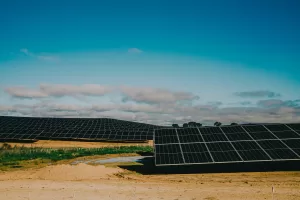
What is A Solar Inverter?
December 01 2023 
Inquiry
Global electronic component supplier AMPHEO PTY LTD: Rich inventory for one-stop shopping. Inquire easily, and receive fast, customized solutions and quotes.
QUICK RFQ
ADD TO RFQ LIST
In this blog, the basic knowledge of solar inverters will be discussed.
What is A Solar Inverter?

How Does a Solar Inverter Work?
A solar inverter converts the direct current (DC) electricity generated by solar panels into alternating current (AC) electricity, the standard form of electricity used in homes, businesses, and the power grid. This conversion process is essential because most electrical devices and appliances are designed to operate on AC power, and the electrical grid itself distributes AC power. Therefore, the solar inverter serves as a crucial link in the chain of solar energy utilization, enabling the energy generated by solar panels to be effectively utilized. When sunlight strikes the solar panels, the photovoltaic cells within the panels generate DC electricity as a result of the photovoltaic effect. This DC electricity is then fed into the solar inverter, which performs several key functions to convert it into usable AC electricity. One of the primary functions of the solar inverter is to convert the variable DC voltage produced by the solar panels into a stable AC voltage that matches the requirements of the electrical grid or the building's electrical system. The solar inverter achieves this conversion through a process known as inversion, which involves several stages. First, the DC electricity from the solar panels is fed into a component called the inverter's DC/DC converter, which adjusts the voltage level to optimize the power output. Next, the DC electricity is passed through the inverter's main component, the inverter bridge, where it undergoes a transformation from DC to AC. This transformation involves the use of semiconductor devices such as insulated gate bipolar transistors (IGBTs) or metal-oxide-semiconductor field-effect transistors (MOSFETs) to switch the DC on and off rapidly, creating an AC waveform. Furthermore, the solar inverter incorporates control and monitoring systems to ensure that the AC output matches the required voltage, frequency, and phase angle for grid-tie applications or building electrical systems. Additionally, many modern solar inverters are equipped with maximum power point tracking (MPPT) capabilities, which optimize the energy harvest from the solar panels by continuously adjusting the operating voltage and current to maximize power output under varying environmental conditions. In summary, a solar inverter works by converting the DC electricity generated by solar panels into stable, grid-compatible AC electricity through inversion and voltage regulation. By performing these functions, the solar inverter enables the seamless integration of solar energy into existing electrical infrastructure, allowing for the efficient and reliable utilization of solar power in homes, businesses, and the broader electrical grid.
What does A Solar Inverter do?
A solar inverter serves several critical functions in a solar power system, playing a pivotal role in the conversion and utilization of solar energy. One of its primary functions is to convert the direct current (DC) electricity generated by solar panels into alternating current (AC) electricity, which is the standard form of electricity used in homes, businesses, and the electrical grid. This conversion is essential because most electrical devices and appliances are designed to operate on AC power, and the electrical grid itself distributes AC power. Therefore, the solar inverter acts as a vital intermediary, ensuring that the energy harnessed from the sun can be effectively utilized. In addition to DC-to-AC conversion, solar inverters also perform voltage regulation and synchronization functions. They ensure that the AC electricity produced by the solar panels matches the required voltage, frequency, and phase angle for seamless integration with the electrical grid or the building's electrical system. This synchronization is crucial for grid-tie applications, where solar power is fed back into the grid, as well as for standalone systems where the solar-generated AC power needs to match the requirements of the local electrical infrastructure. Furthermore, many modern solar inverters are equipped with advanced features such as maximum power point tracking (MPPT), which optimizes the energy harvest from the solar panels by continuously adjusting the operating voltage and current to maximize power output under varying environmental conditions. This capability allows the solar inverter to extract the maximum amount of energy from the solar panels, enhancing the overall efficiency and performance of the solar power system. Moreover, solar inverters often incorporate monitoring and control systems that enable users to track the performance of their solar power system, monitor energy production, and diagnose any issues that may arise. These monitoring capabilities provide valuable insights into the system's operation, allowing users to optimize energy production, identify potential maintenance needs, and ensure the system operates at peak efficiency.Conclusion
In summary, a solar inverter plays a multifaceted role in a solar power system. It converts DC electricity to AC electricity, regulates voltage and frequency, synchronizes with the electrical grid, optimizes energy harvest through MPPT, and provides monitoring and control capabilities. By performing these functions, the solar inverter enables the efficient and reliable utilization of solar energy, whether for grid-tie applications, standalone systems, residential installations, or commercial solar projects.Related Articles
Populer Posts
